Abstract
Our research scrutinizes the impact of grease rheological properties on the lubrication performance of wind turbine spindle bearings. The rheological behavior of three distinct commercial wind turbine greases was examined with a rotational rheometer. Investigations into the viscoelastic, flow, and viscosity–temperature attributes of the grease under varying temperatures were conducted, and the rheological parameters were fitted utilizing the Herschel–Bulkley (H–B) model. Constitutive equations of the grease derived from fitting the H–B model can efficaciously predict its rheological properties and viscosity–temperature behavior for wind power spindle bearings at disparate temperatures.
1. Introduction
As one of the core components in the critical part of wind turbines, bearings ensure the smooth rotation of the equipment. However, the life cycle of bearings can be greatly affected by uneven operating loads and environmental conditions, which can also increase the MOR (maintenance, operation, and reliability) costs of the entire wind turbine [1]. If the spindle bearing has problems, it may lead to consequences such as increased equipment maintenance costs or the replacement of parts and other consequences that affect the power generation efficiency. In severe cases, it may even cause mechanical failures and safety accidents, such as fires, resulting in serious losses [2,3]. In order to avoid the loss of power generation and reduce the maintenance costs of parts caused by the failure of wind turbines, it is crucial to conduct effective research and analyses of bearings [4].
The main shaft bearing of wind turbines, as a special bearing, generally uses grease as a lubricant [5]. For greases, the study of rheology has become an important field. Scientists pay close attention to the factors influencing the rheological properties of greases and use rheological parameters, such as the yield stress, apparent viscosity, and plasticity index, to quantitatively describe their rheological properties [6,7].
Scientists from various countries began studying the flow and lubrication characteristics of grease in bearings as early as the 1960s. In a study of the rheological properties and numerical solutions of greases, Bell et al. [8] chose the Ree–Eyring rheological model for non-Newtonian fluids in 1962. In addition, Jonkisz and Krzeminsk-Freda et al. [9] obtained a complete numerical solution of the elastohydrodynamic problem in grease line contact based on the Herschel–Bulkley rheological model in 1996. In the 21st century, researchers have been conducting more in-depth studies on the rheological behavior of greases. In 2018, Wang et al. [10] characterized the effect of ionic liquids on the rheological properties of lithium greases by small-amplitude oscillation shear (SAOS) measurements and confirmed that ionic liquids are effective additives for improving the friction and wear-reduction properties of PAO 10 lithium greases. In 2019, Mohamad et al. [11] conducted an experimental study on the main properties of two magnetorheological greases with different particle shapes. The results showed that the bidisperse magnetorheological grease containing flaky spherical carbonyl iron particles exhibited an increase in the initial apparent viscosity and stiffness properties compared to those of a sample containing only spherical particles. In the same year, Wang et al. [12] tested and discussed the magnetically induced stress–strain curves of magnetorheological greases as a function of the spherical carbonyl iron particle content, shear rate, and shear deformation under quasi-static monotonic shear conditions. Mohd Nasir et al. [13] investigated the improvement in the rheological properties of magnetorheological greases by introducing graphite as an additive in 2021 and compared their properties with those of reference samples. In the same year, a boric acid–hydroxystearic acid composite lithium-based magnetorheological grease was proposed by Yan et al. [14] to improve the rheological properties of conventional magnetorheological greases. The experimental results verified the feasibility of the lithium-based composite magnetorheological grease to improve performance. In 2022, Wang et al. [15] found that fewer layers of graphene additives could improve the viscosity–temperature properties of complex lithium-based greases and change the response rate of elastic deformation to temperature changes.
The rheological properties of grease directly affect its flow performance and lubricating effect in bearings. The study of grease rheology can guide grease formulation design, production process optimization, and spindle bearing operation and maintenance, further improving the life and performance of spindle bearings as well as ensuring the safe and reliable operation of wind turbines [16,17,18]. In order to improve the lubrication performance of wind turbine bearings, the next step should be to investigate the rheological properties of grease at low and medium shear rates, which is the focus of this paper. In this study, dynamic and steady-state rheological tests were performed on three different commercial greases using a rotational rheometer to investigate the viscoelastic, flow, and viscosity–temperature properties of the grease at different temperatures; secondly, the Herschel–Bulkley model was used to fit the grease based on the dependence of the apparent viscosity on the shear rate. Finally, the intrinsic equations of the grease obtained after fitting the H–B model successfully predicted the rheological properties and viscosity–temperature behavior of the grease for wind power spindle bearings at different temperatures, which provided a reference for predicting the performance of the grease under different conditions.
2. Experimental Section
2.1. Test Equipment
The rheological properties of grease were studied using an Anton Paar MCR302 rotational rheometer, which has a speed range of 10−6~200 r/min and a measuring torque of 10 μN·m to 0.2 N·m. The built-in RheoCompass application was used for initial condition setting, parameter control, test data output, and post data analysis.
2.2. Test Scheme Design
Rheological property tests are carried out in the operating temperatures of −20, 20, 60, and 100 °C to test parameters such as apparent viscosity, yield stress, thixotropy, viscoelasticity, viscosity–shear relation, and viscosity–temperature relationship of grease. The general experimental scheme is shown in Figure 1. These experiments can provide theoretical and experimental support for the optimization of the lubrication system of wind power spindle bearings.

Figure 1.
Grease rheology experimental scheme.
Dynamic and steady-state rheological tests were conducted to determine the rheological properties of wind turbine spindle bearing grease. The dynamic rheological test is mainly used to test the rheological characteristics of grease in the process of oscillating shear to reflect the degree of viscoelastic change. By controlling the oscillation strain and frequency of the grease, the dynamic shear modulus, damping ratio, staggered strain, and other parameters can be obtained under different conditions [19]. The steady-state rheological test is mainly used to measure the shear stress of grease with shear rate in the continuous shear process. By applying different shear rates to observe the shear stress response of grease, rheological parameters, such as shear viscosity, rheological index, and yield point of grease, can be measured [20,21]. The rheometer was tested in the strain control, stress control, and controlled-shear rate modes. The measuring rotor was PP25, and the measuring distance was set to 1 mm. To ensure the accuracy and repeatability of the experiment, Peltier heating system was used as the temperature control system, and P-PTD200 heating plate and H-PTD 200 heating cover were used to jointly control the temperature to ensure that the sample was under uniform temperature control.
Design plans for dynamic and steady-state rheological tests are presented below:
- Dynamic rheological test
The dynamic rheological test is divided into strain and frequency scan experiments. The strain scan experiment is used to test the variation law of storage modulus and loss modulus with strain value during the amplitude scan of grease, which reflects the viscoelastic properties of grease in oscillatory shear. The frequency scan experiment is used to test the changes in storage modulus and loss modulus of grease at different frequencies, which reflect the viscoelastic properties of grease at different frequencies. During the experimental operation, the angular velocity was kept constant at 10 rad/s, and the strain range was 0.1% to 100%. To obtain the viscoelastic and stress–strain curves of grease at different temperatures, the control temperatures were −20, 20, 60, and 100 °C, and amplitude scanning experiments were performed. The relationship between the storage modulus, the loss modulus of the grease at different temperatures, and shear strain can be derived from the test results.
- 2.
- Steady-state rheological test
The continuous shear mode of the rheometer was selected, the shear rate was controlled in the range of 0.01 s−1 to 100 s−1, and the temperature was kept at −20, 20, 60, and 100 °C for steady-state rheological experiments to obtain the relationship between the apparent viscosity of grease and the shear rate at different temperatures, as well as the viscosity–shear rate curves of grease at different temperatures. In addition, a constant shear rate of 50 s−1 was applied to the temperature range (−20 °C~20 °C, 60 °C~100 °C) for temperature scanning experiments to measure the viscosity–temperature relationship and obtain the viscosity–temperature curve of the grease under constant shear rate conditions. The use of this shear rate is explained by the fact that most of the samples reached a Newtonian plateau at high shear rates [22].
2.3. Grease Selection
Three different brands of grease, Mobil SHC 461WT complex lithium base, Fuchs 585K plus complex calcium base, and Haihua FCL1 complex metal soap base, were selected for the test, as shown in Figure 2. Mobil SHC 461WT grease is one of the more common greases on the market, while Fuchs 585K plus and Haihua FCL1 are newer greases. Mobil SHC 461WT is a high-performance lithium grease with a synthetic base oil, typically a polyolefin or polyester compound. These base stocks have a high viscosity index and good fluidity at low temperatures. The thickener in grease is mainly lithium-12-hydroxystearate. Its function is to increase the viscosity and freezing point of the grease to provide good lubricating performance and stability. Fuchs 585K plus complex calcium-based grease uses special thickeners and additives to provide excellent lubrication and corrosion protection in harsh environmental conditions. Haihua FCL1 complex lithium-based grease adopts advanced formulation technology and a thickening system that has excellent high-temperature resistance and excellent anti-pollution performance and can maintain stable lubricating performance in the long term. The three different brands of wind power spindle bearing greases were selected for rheological property testing to take into account the differences between different greases used in practical engineering applications, to investigate the effects of different base oils and thickeners on the rheological properties of wind power greases, and to compare their performance at different temperatures and shear rates. This provides a scientific basis for the selection and application of wind turbine spindle bearing greases. The relevant parameters of the three types of grease are shown in Table 1.

Figure 2.
Different types of greases. (a) Mobil SHC 461WT; (b) Fuchs 585K plus; (c) Haihua FCL1.

Table 1.
The relevant parameters of the three types of grease.
In order to facilitate experimental analysis, sample 1 represents Mobil SHC 461WT, sample 2 represents Fuchs 585K plus, and sample 3 represents Haihua FCL1.
3. Experimental Results and Discussion
3.1. Influence of Grease Viscoelastic Properties on Bearing Lubrication
The viscoelastic properties of grease refer to the dynamic process of stress–strain changes under loading, which can be described by the stress–strain relationship. The ratio of stress amplitude to strain amplitude is called the complex modulus, as shown in Formula (1).
In the formula, is the stress amplitude, and is the strain amplitude.
According to the magnitude of phase difference, the complex modulus can be decomposed into the storage modulus and loss modulus, as shown in Formulas (2) and (3).
In the formula, δ is the phase difference, G* is the complex modulus, G′ is the storage modulus, and G″ is the loss modulus.
According to the definition of the modulus of elasticity, G′ represents the elastic part, which represents the energy stored in the grease when it is subjected to cyclic stress; G″ is called the loss modulus, which represents the energy lost when the grease is subjected to external forces. The ratio of the loss modulus to storage modulus is called the loss factor, as in Formula (4).
When tanδ < 1, the grease behaves as a semi-solid gel at this point. When the storage modulus tanδ > 1, the grease is expressed as a liquid at this point. When the storage modulus tanδ = 1, it means that the viscosity and elasticity in the grease are equal. At that point, the grease has an intermediate behavior between a liquid and a solid, and the strain value in the stress–strain curve is the flow point of the grease.
Dynamic viscoelastic properties of greases are typically measured using the oscillatory mode of a rotational rheometer, which measures the input strain amplitude , the output stress amplitude , and the phase difference between the two for a range of given frequencies . The phase difference represents the time delay of the stress and strain. Using these parameters, the complex modulus and loss factor of grease can be calculated, and then the storage modulus and loss modulus, which represent the elastic and viscous properties of grease, can be decomposed.
The stress–strain curves of the three greases at different temperatures are shown in Figure 3.
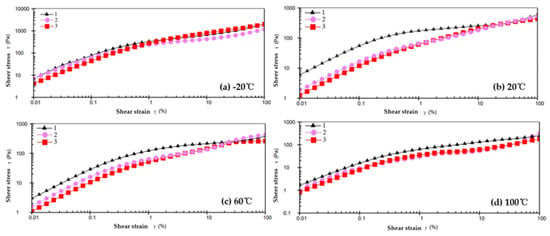
Figure 3.
Stress–strain curve of grease. (a) −20 °C; (b) 20 °C; (c) 60 °C; (d) 100 °C.
As shown in Figure 3a, the shear stress of the three greases is low at −20 °C, and all three greases exhibited a high viscoelasticity due to the positive correlation between the shear strain and shear stress. Figure 3b shows the stress–strain variation in the three greases at 20 °C. The stress–strain curves of the three greases at 20 °C showed different trends. The shear stress of sample 1 showed a rapidly increasing trend with the increase in strain, indicating a higher shear consistency. This indicates that sample 1 has a higher viscosity and higher shear consistency at the same temperature.
According to the experimental results shown in Figure 3c, the movement of the grease molecules is intensified with the increase in temperature, the viscosity decreases, the rheology of the grease is more similar to fluid, and the relationship between the shear strain and shear stress is more nonlinear. However, compared with that of sample 1 and sample 2, the shear stress of sample 3 increases less at 60 °C, which may be related to its composition. According to the conclusion that sample 3 is a composite metal soap-based grease, it can be inferred that the composite metal soap component in sample 3 may have better shear resistance, so the shear stress increase is small.
At 100 °C, the stress–strain pattern of all three greases showed a shear dilution compared to the data at 20 °C and 60 °C, as shown in Figure 3d. Among them, with a small shear strain of the grease, the shear stress of sample 1 showed a linear relationship with the increase in the shear strain, the stress growth rate gradually decreased, and the stress–strain curve showed a bending trend. This phenomenon may be due to the increase in the strain, which causes the colloidal structure of the grease thickener particles to break down, resulting in a decrease in the viscosity inside the grease and making the shear stress growth rate gradually decrease and finally stabilize.
The following are further analyzed by combining the viscoelastic modulus and loss factor. Figure 4 shows the variation curves for the elastic modulus and viscous modulus of the grease with strain at four temperatures.
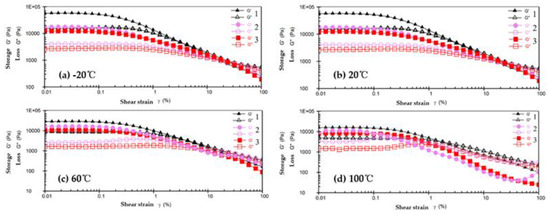
Figure 4.
Variation curve of viscoelastic modulus with strain for grease. (a) −20 °C; (b) 20 °C; (c) 60 °C; (d) 100 °C.
As shown in Figure 4a, the three greases exhibit a high modulus of elasticity at low temperatures, and their rheological properties appear only with increasing shear strain.
Figure 4b,c show the variation curves of the viscoelasticity with strain for the three greases at 20 °C and 60 °C. Among them, when the temperature increases from 20 °C to 60 °C, the strain values corresponding to the flow points of the three greases decrease significantly with the increase in temperature, which also proves the phenomenon of the shear dilution of the grease, indicating that the fluidity of the grease is effectively improved with the increase in temperature.
When the temperature reaches 100 °C, as shown in Figure 4d, as the strain amplitude increases, the storage modulus decreases slowly and then rapidly, and the loss modulus tends to increase gradually. This is related to the so-called “weak strain overshoot”.
It can be seen that the viscoelastic modulus of the three greases at different temperatures is affected by the temperature and strain. For the same strain conditions, the viscoelastic modulus decreases with increasing temperature, while it increases with increasing strain at the same temperature.
In order to more accurately describe the change law of the grease properties during strain scanning, the data of the loss factor of the grease with strain values at different temperatures were experimentally obtained, as shown in Figure 5. The variation law of the loss factor with strain can directly reflect the energy loss of the grease under the action of force and can also more intuitively represent the viscoelastic properties and rheological nature of grease.
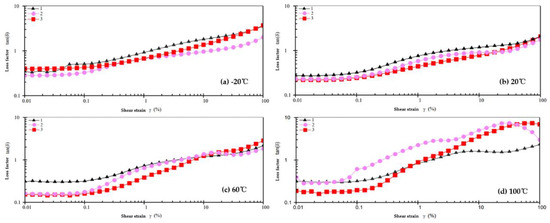
Figure 5.
Loss factor (tanδ) variation curve of grease. (a) −20 °C; (b) 20 °C; (c) 60 °C; (d) 100 °C.
As can be seen in Figure 5a, all three greases can flow better at a low temperature of −20 °C. However, the low temperature flow of sample 1 is better and it starts to flow at a strain value of about 1.34%. The strain values corresponding to the three greases were similar when the loss factor reached 1 at 20 °C and 60 °C, but the strain values decreased slightly with increasing temperature. The changes in the three greases at room temperature were basically similar, as shown in Figure 5b,c.
When the temperature reached 100 °C, as shown in Figure 5d, the loss factor increased with increasing strain, but there was no overall upward trend. To illustrate the above situation more clearly, the viscoelastic modulus and corresponding strain values of the three greases at different temperatures at the flow point are given in Table 1.
According to the data in Table 2, it can be seen that the storage modulus and loss modulus of the three greases decrease with the increase in temperature at different temperatures, which indicates that the energy stored in the elastic deformation and the energy lost in the viscous flow of the grease decrease with the increase in temperature. This indicates that the viscoelastic parameters of the grease are effectively improved with increasing temperature. This plays an important role in improving the performance and effectiveness of wind power grease, reducing energy loss, prolonging service life, and increasing the efficiency and reliability of wind power generation systems.

Table 2.
Values related to viscoelastic modulus of grease at the flow point at different temperatures.
3.2. Influence of Grease Fluidity on Bearing Lubrication
The shear stress of grease is the intermolecular force within the grease, which is a direct measure of the viscosity. The shear rate is a measure of the magnitude of the shear stress on the grease, usually expressed in terms of the shear deformation per unit of time.
For wind turbine spindle bearing lubrication, the rheological properties of the grease are an important factor affecting its performance. In general, the rheological properties of the grease should also meet the following requirements, as shown in Table 3.

Table 3.
Requirements for rheological properties of grease.
Figure 6 shows the shear stress versus shear rate curves for samples 1, 2, and 3, all at different temperatures.
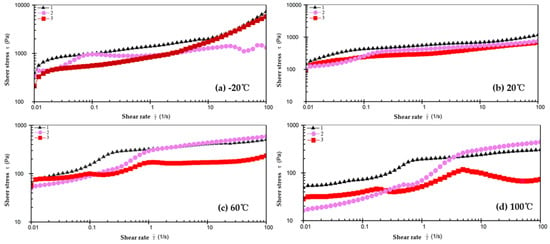
Figure 6.
Shear stress–shear rate rheological curve of grease. (a) −20 °C; (b) 20 °C; (c) 60 °C; (d) 100 °C.
According to the data shown in Figure 6a, the shear stress of the three greases increased with the increase in the shear rate at −20 °C. The molecular structures of samples 1 and 3 were relatively stable at low temperatures. The shear stress of sample 2 increased rapidly with the increase in the shear rate and showed an obvious shear yielding phenomenon at a shear rate of about 30 s−1, which was due to the relative fragility of the colloidal structures of sample 2 at low temperatures and its susceptibility to yielding damage.
Figure 6b shows a slight difference in the initial shear stresses of the three samples at a temperature of 20 °C, which is due to the different molecular structure and composition of the grease. The shear stress increases with the temperature at 20 °C for all three greases, but the growth rate slows. This shows that the shear performance of grease in a given temperature range changes with increasing temperature, but the degree of the influence of the temperature on the shear performance of grease decreases with increasing temperature.
The shear stresses of the three greases at 60 °C showed a gradual slowing of the upward trend as the shear rate increased, as shown in Figure 6c. The initial shear stress of the grease at this temperature is lower than that at 20 °C and −20 °C, indicating that the grease flows and deforms more easily at 60 °C. For sample 2, the shear stress increases relatively quickly, which is related to the higher mobility of the molecular structure of sample 2 at 60 °C.
Figure 6d shows that as the temperature rises to 100 °C, the shear stresses of the three greases initially increase and then level off. This phenomenon shows that the lubricating performance of the three greases is affected by the temperature and shear rate, and the lubricating performance of each grease varies with different working conditions.
In summary, with the increase in the shear rate, the shear stress curves of the three greases at different temperatures show the phenomenon of shear yielding. When the temperature and shear rate increase, the thermal movement of molecules is enhanced, the intermolecular forces are reduced, the flow resistance endured in the process of movement is reduced, and the grease flows easier. To better describe the changes in the shear stress and shear rate in the fluidity of grease, the following is combined with the fixed temperature viscous shear curve for further analysis.
As can be seen from Figure 7a, the viscosity of the three greases decreases with the increase in the shear rate, and the decreasing trend is basically the same. Samples 1 and 3 can maintain a uniform decreasing trend as the shear rate increases, so it can be judged that they have a better low-temperature fluidity, high viscosity, and large viscosity. The viscosity of sample 2 was higher at a low shear rate, and the viscosity decreased more slowly; however, the viscosity decreased sharply at a high shear rate as the shear rate continued to increase. Thus, it can be judged that sample 2 was less fluid at a low temperature and high shear rate.
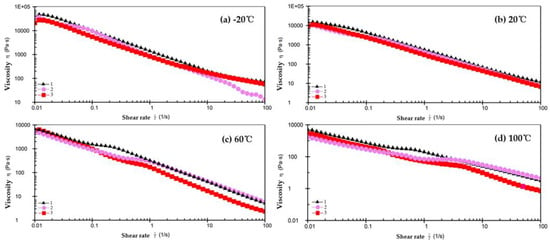
Figure 7.
Viscosity–shear rate rheological curve of grease. (a) −20 °C; (b) 20 °C; (c) 60 °C; (d) 100 °C.
As shown in Figure 7b, the viscosity of the three greases decreases smoothly with the increasing shear rate at 20 °C. In addition, all three greases showed shear sensitivity at low shear rates at 60 °C, as shown in Figure 7c, but as the shear rate increased, the final viscous shear curve tended to be smooth, indicating that all three greases had good shear stability at high shear rates.
As can be seen in Figure 7d, the apparent viscosity of the three greases at 100 °C showed a significant decrease with the increase in the shear rate, which is because the high temperature enhances the movement of the grease molecules and the interaction between the molecules weakens, leading to the decrease in their viscosity. The viscous shear curves of the three greases showed different trends for the shear rate variations. Table 4 summarizes the viscosity change pattern of the three greases at different temperatures and shear rates ranging from 0.01 s−1 to 100 s−1.

Table 4.
Variation of grease viscosity with shear rates ranging from 0.01 s−1 to 100 s−1 at different temperatures.
The experiments show that the increase in temperature increases the internal molecular thermal movement of the grease, and the intermolecular interaction force decreases. The arrangement becomes looser, its viscosity decreases, and it is easy to lose the lubricating effect under a high temperature and a high shear rate. Therefore, it can be seen that the thermal rheological properties of the grease have an important effect on the lubrication performance of the bearing. Under high-speed rotation, the bearing generates a large shear rate and is accompanied by an increase in temperature. The selection of a grease with a suitable viscosity–shear rate ratio can ensure that the bearing can still provide sufficient lubrication under high-speed rotation.
3.3. Influence of Grease Viscosity–Temperature Characteristics on Bearing Lubrication
The viscosity of grease changes with temperature, and this change can be expressed by the viscosity–temperature curve. The viscosity–temperature curve is the most common method of studying the effect of temperature on the rheological properties of grease and describes the law of grease viscosity changes with temperature. The relationship between grease viscosity and temperature can be described using the Arrhenius equation [23], which expresses the relationship between the chemical reaction rate constants and temperature. The formula is as follows:
In the formula, k is the reaction rate constant, A is a constant, Ea is the activation energy of the reaction, R is the gas constant, and T is the temperature. The items in brackets can be interpreted as the temperature sensitivity of the reaction, and as the temperature increases, the value in the index becomes smaller and the reaction rate constant increases accordingly. In the study of grease rheology, this formula is used to describe the change in viscosity of a grease with temperature. Measurements of the viscosity and temperature change characteristics of a grease typically use the shear mode of a rotational rheometer, which allows the instrument to apply shear stress at a given rate and measure the shear stress response of the grease to calculate its viscosity. The measuring process changes the temperature within a certain range and records the viscosity values at different temperatures to plot the viscosity–temperature curve of the grease.
Figure 8 shows the viscosity change law with temperature for the three greases at a constant shear rate of 50 s−1 and a temperature range of −20~20 °C and 20~100 °C.
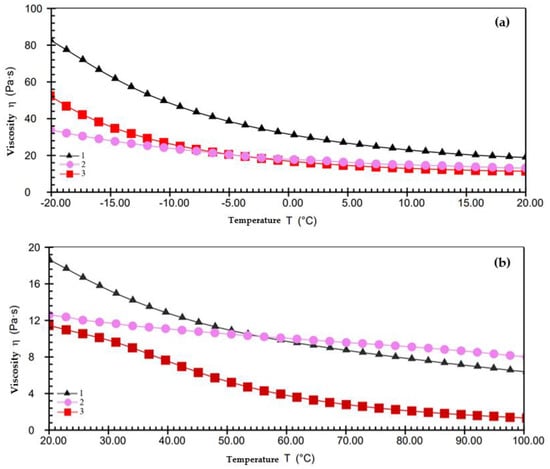
Figure 8.
Viscosity–temperature rheological curve of grease. (a) −20 °C to 20 °C; (b) 20 °C to 100 °C.
As shown in Figure 8a, all three greases have excellent fluidity from a low temperature to room temperature, the viscosity is more stable after the temperature rises, and the greases can maintain a good lubricating effect at room temperature.
Figure 8b shows the change in viscosity of the three greases for the range of 20 °C to 100 °C. Samples 1 and 2 contain more high-viscosity base oils that still maintain a high viscosity at high temperatures, resulting in a smaller decrease in the overall viscosity of the grease. Sample 3 contains more low-viscosity base oils and additives, and these components are easily broken down at high temperatures, resulting in a greater decrease in the overall viscosity of the grease.
It was concluded that all three grease viscosities showed a decreasing trend with increasing temperature at a constant shear rate of 50 s−1. By understanding the viscosity–temperature curve of grease, it is possible to better select an appropriate grease and understand the changes in the fluidity and viscosity of greases at different temperatures so that lubrication failures can be detected and resolved in time to ensure the normal operation of wind turbine bearings.
3.4. Results and Discussion
This part investigates the rheological properties of wind turbine bearing grease, further discusses the effects of the temperature, shear rate, and stress–strain on the rheological properties, and combines the simulated experimental results with an in-depth analysis of the viscoelastic properties, flow properties, and viscous temperature properties of grease on bearing lubrication at different temperatures, leading to the following conclusions:
- From the stress–strain curves of grease samples 1, 2, and 3 at different temperatures and the corresponding energy storage and loss modulus with strain, it can be seen that different greases have different viscoelastic properties at different temperatures. At a low temperature, the storage modulus and loss modulus of grease are higher, which means that the grease has better elasticity and viscoelasticity under these conditions and can better perform in terms of lubrication and buffering. Meanwhile, at a high temperature, the loss modulus of grease obviously increases, which indicates that the viscoelastic capacity decreases, and the viscosity of grease decreases, which reduces the lubricating effect.
- Under each temperature condition, the shear stress of the three greases increased with the increasing shear rate, while the viscosity decreased with the increasing shear rate, but the decreasing and increasing trends of the three samples were different. The grease flow curve also shows that temperature has an effect on its rheological properties. For wind turbine spindle bearings, it is important to focus on the grease’s viscosity change and shear resistance at high temperatures to ensure efficient bearing lubrication.
- Grease viscosity is closely related to temperature and has an essential effect on the lubrication performance of wind turbine bearings. If the viscosity of the grease drops too low, the lubricating film will be lost because the grease cannot maintain sufficient adhesion at high temperatures, resulting in overheating, wear, and corrosion of wind turbine bearings. Therefore, when selecting grease, if the application environment’s temperature is low, it is necessary to select grease with a higher viscosity to ensure the lubricating effect. In a high-temperature environment, it is necessary to select grease with a lower viscosity to avoid the effect of lubrication due to a high viscosity.
4. Rheological Modeling
The rheological properties of non-Newtonian fluids are a key research direction in the study of grease rheology [24], and the concept of rheological models has been introduced by researchers to quantitatively describe the flow patterns of greases. The current rheological model that can adequately describe wind turbine spindle bearing grease is the Herschel–Bulkley model, which can accommodate a variety of rheological characteristic curves, including shear stress–shear rate curves, strain scan curves, and viscous temperature curves, etc. [25,26]. At the same time, it can fit the experimental data well, treat grease as a structural system composed of viscoelastic and viscous components, reflect the structural properties of grease, help to analyze and optimize the performance of grease, and improve the prediction accuracy. The constitutive equation is as follows:
In the formula, is the yield stress of the grease, is the flow behavior index, n is the shear thinning index, and is the shear rate of the grease. Based on the obtained data for the rheological properties of the grease, the trend of the apparent viscosity of the grease with shear rates at different temperatures was considered, and the curve was found to fit the rheological data better by analyzing the rheological data obtained under the continuous shear mode. Therefore, the experimental data were used to fit the rheological equations and calculate the values of the H–B model parameters to express the law of variation for each shear stress curve.
The rheological equations for the three greases at different temperatures are shown in Table 5.

Table 5.
Grease rheological formula at different temperatures.
It can be seen that the yield stress of the three greases decreases with the increase in temperature, indicating that the structural strength limit of the grease decreases with the increase in temperature. In addition, the increase in temperature also causes the viscosity coefficient of the grease to decrease, which is why the grease has better fluidity as the temperature increases, thus promoting flow in the bearing. However, if the temperature is high enough, the viscosity of the grease will decrease, causing it to be easily thrown out of the bearing and impairing its lubricating effect. In conclusion, the fluidity of grease is related to temperature to a certain extent, and the temperature factor must be fully considered in practical applications.
According to the experimental data given in Table 4, the data fit of the H–B model to the flow curve was plotted in linear coordinates as shown in Figure 9. The results show that the rheological model fits the experimental data well, and the rheological parameters can be used to describe the rheological properties of the grease by the rheological model, so as to obtain the intrinsic equation of the grease at each temperature.
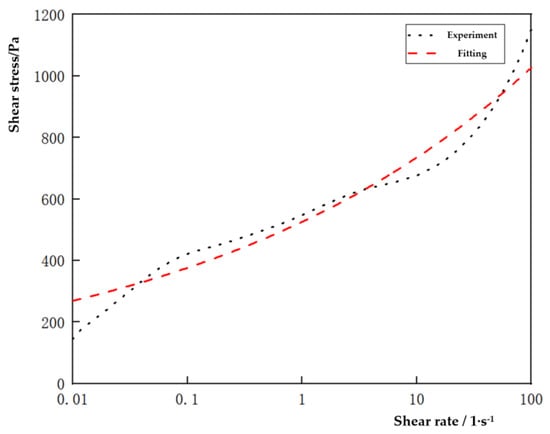
Figure 9.
Comparison of fitted equation and experimental data for sample 1 at 20 °C.
5. Summary
The main shaft bearing of a wind turbine is one of the critical core components in a wind turbine system, and its stability and service life have a key impact on the performance and reliability of the whole wind turbine system. Thus, it is important to study the rheological lubrication characteristics of bearings to ensure the normal operation and long-term stability of wind turbine systems [27,28]. The study of bearings’ rheological lubrication characteristics can improve their lubrication efficiency and anti-wear capacity, reduce friction losses, reduce the consumption of lubricants and energy, and reduce maintenance costs.
In this paper, the influence of the rheological properties of grease on the lubrication performance of wind power spindle bearings is analyzed in detail, the influence of grease for different working temperatures and shear rates is analyzed, experimental research is conducted, and a constitutive equation of wind power spindle grease is obtained by fitting the H–B model according to the experimental data. The paper concludes as follows:
- As the temperature increases, the slope of the stress–strain curve of the grease becomes smaller, indicating that the grease flows more easily under high-temperature conditions, while the increase in temperature also causes the storage modulus and loss modulus of the grease to decrease. At a low temperature, the viscoelastic modulus of grease is higher, and with increasing temperature, the viscoelastic modulus gradually decreases.
- The shear stress of the grease increases with increasing shear rates, which is in contrast to the decrease in viscosity with increasing shear rates. In addition, as the temperature increases, the thermal movement of the molecules in the grease increases, resulting in a decrease in the intermolecular interaction force and a looser arrangement, which reduces the viscosity of the grease and makes it easy to lose lubrication at high temperatures and shear rates. For operating wind turbine spindle bearings at high speeds, it is best to select a grease that can resist shear at high temperatures to ensure the good lubrication performance of the bearings.
- The viscosity of grease decreases as the temperature increases, primarily because the grease molecules flow more easily at high temperatures, resulting in a decrease in the grease viscosity. When selecting a grease, it is necessary to consider its viscosity and temperature characteristics. In high-temperature conditions, the use of lower-viscosity grease can ensure the lubrication performance of wind power spindle bearings; in contrast, in low-temperature conditions, the use of higher-viscosity grease can better maintain the fluidity of the grease.
- The H–B model can reflect the sensitivity of the grease viscosity–temperature behavior to temperature changes. The intrinsic equation of grease obtained by fitting the H–B model can effectively predict the rheological properties and viscosity–temperature behavior of grease at different temperatures, which provides a reference for predicting the performance of grease under different conditions.
In the actual production process, the rheological behavior of grease is also affected by its frictional properties. In order to more comprehensively study the rheological properties of grease under actual working conditions, it is necessary to introduce a four-ball friction and wear tester, an SRV tester, and other equipment to consider the frictional properties of grease, which is the direction of our further research.
Author Contributions
Conceptualization, H.P. and S.L.; methodology, L.S., D.Z. and S.L.; investigation, D.Z., H.Z. and H.P.; validation, H.P. and L.S.; resources, S.L.; writing—original draft preparation, S.L.; writing—review and editing, H.P. and D.Z.; supervision, L.S.; project administration, D.Z.; funding acquisition, H.P. All authors have read and agreed to the published version of the manuscript.
Funding
This study was funded by 22IRTSTHN018 “Science and Technology Innovation Team Support Program for Universities in Henan Province” and “North China University of Water Resources and Electric Power’s Young Backbone Project Support Program”.
Institutional Review Board Statement
Not applicable.
Data Availability Statement
Not applicable.
Conflicts of Interest
The authors declare no conflict of interest.
References
- Yan, J.; Liu, Y.; Ren, X. An Early Fault Detection Method for Wind Turbine Main Bearings Based on Self-Attention GRU Network and Binary Segmentation Changepoint Detection Algorithm. Energies 2023, 16, 4123. [Google Scholar] [CrossRef]
- Available online: https://www.sohu.com/a/553148021_120097033 (accessed on 1 June 2022).
- Available online: https://www.163.com/dy/article/H4P0LA660514C30V.html (accessed on 12 April 2022).
- Afridi, Y.S.; Hasan, L.; Ullah, R.; Ahmad, Z.; Kim, J.-M. LSTM-Based Condition Monitoring and Fault Prognostics of Rolling Element Bearings Using Raw Vibrational Data. Machines 2023, 11, 531. [Google Scholar] [CrossRef]
- Bayer, G.; Bartschat, A.; Wandel, S.; Baust, S.; Poll, G. Experimental Investigations on Wear in Oscillating Grease-Lubricated Rolling Element Bearings of Different Size and Type. Lubricants 2023, 11, 120. [Google Scholar] [CrossRef]
- Wandel, S.; Bader, N.; Schwack, F.; Glodowski, J.; Lehnhardt, B.; Poll, G. Starvation and relubrication mechanisms in grease lubricated oscillating bearings. Tribol. Int. 2022, 165, 107276. [Google Scholar] [CrossRef]
- Frache, L.; Komba, E.H.; Philippon, D.; Galipaud, J.; De Barros, M.; Douillard, T.; Masenelli-Varlot, K.; Bouscharain, N.; Maheo, Y.; Sarlin, R.; et al. Observation of a modified superficial layer on heavily loaded contacts under grease lubrication. Tribol. Int. 2021, 158, 106921. [Google Scholar] [CrossRef]
- Bell, J.C. Lubrication of Rolling Surfaces by a Ree-Eyring Fluid. ASLE Trans. 1962, 5, 160–171. [Google Scholar] [CrossRef]
- Henryk, F.; Bogdan, W. Correction of the roller generators in spherical roller bearings. Wear 1996, 192, 29–39. [Google Scholar]
- Wang, Z.; Chang, J.; Cai, C. Tribological Performance of Phosphonium Ionic Liquids as Additives in Lithium Lubricating Grease. Lubricants 2018, 6, 23. [Google Scholar] [CrossRef]
- Mohamad, N.; Ubaidillah; Mazlan, S.A.; Choi, S.-b.; Abdul Aziz, S.A.; Sugimoto, M. The Effect of Particle Shapes on the Field-Dependent Rheological Properties of Magnetorheological Greases. Int. J. Mol. Sci. 2019, 20, 1525. [Google Scholar] [CrossRef]
- Wang, H.; Zhang, G.; Wang, J. Quasi-Static Rheological Properties of Lithium-Based Magnetorheological Grease under Large Deformation. Materials 2019, 12, 2431. [Google Scholar] [CrossRef]
- Mohd Nasir, N.A.; Nazmi, N.; Mohamad, N.; Ubaidillah, U.; Nordin, N.A.; Mazlan, S.A.; Abdul Aziz, S.A.; Shabdin, M.K.; Yunus, N.A. Rheological Performance of Magnetorheological Grease with Embedded Graphite Additives. Materials 2021, 14, 5091. [Google Scholar] [CrossRef] [PubMed]
- Yan, H.; Li, P.; Duan, C.; Dong, X. Studies with Rheological Behavior of Composite Lithium-Based Magnetorheological Grease. Metals 2021, 11, 1826. [Google Scholar] [CrossRef]
- Wang, Y.; Gao, X.; Lin, J.; Zhang, P. Rheological and Frictional Properties of Lithium Complex Grease with Graphene Additives. Lubricants 2022, 10, 57. [Google Scholar] [CrossRef]
- Svetlana, N.; Anastasiya, Y.; Sergey, O. Rheological and tribological properties of low-temperature greases based on cellulose acetate butyrate gel. Carbohydr. Polym. 2021, 272, 118509. [Google Scholar]
- Lugt, P.M.; van Zoelen, M.T.; Vieillard, C.; Berens, F.; Gruell, R.; Preisinger, G.; Meaney, P. Grease performance in ball and roller bearings for all-steel and hybrid bearings. Tribol. Trans. 2021, 65, 1–13. [Google Scholar] [CrossRef]
- Sun, L.; Ma, R.; Zhao, Q.; Zhao, G.; Wang, X. The Impact of Water on the Tribological Behavior of Lubricating Grease Based on Calcium Carbonate Polymorphs. Lubricants 2022, 10, 188. [Google Scholar] [CrossRef]
- Chen, J.X. Research on grease removal collection for wind turbine pitch bearings. Wind Energy 2019, 10, 74–77. [Google Scholar]
- Zhai, G.; Qin, X.; Yang, X. Research on real working condition simulation and performance test of wind power main bearing based on test bench. Math. Probl. Eng. 2021, 2021, 6623988. [Google Scholar] [CrossRef]
- Zhang, X.W.; Yang, X.B.; Liu, M.; Yang, G.L. Working principle and application of single-line lubrication system for wind turbine. Mech. Res. Appl. 2020, 33, 217–219, 222. [Google Scholar]
- Pablo, M.; María, D.; Joaquín, A.; Francisco, J.; José, S.; María, D.; Ramón, P. Physicochemical characterisation of graphene-ammonium lactate ionic liquid nanofluid. J. Mol. Liq. 2022, 367, 120446. [Google Scholar]
- Liu, X.; Su, Q.; Zhu, J.; Song, X. The Aging Behavior and Life Prediction of CFRP Rods under a Hygrothermal Environment. Polymers 2023, 15, 2490. [Google Scholar] [CrossRef] [PubMed]
- Konan, N.A.; Rosenbaum, E.; Massoudi, M. On the Response of a Herschel–Bulkley Fluid Due to a Moving Plate. Polymers 2022, 14, 3890. [Google Scholar] [CrossRef] [PubMed]
- Westerberg, L.-G.; Farré-Lladós, J.; Sarkar, C.; Casals-Terré, J. Contaminant Particle Motion in Lubricating Grease Flow: A Computational Fluid Dynamics Approach. Lubricants 2018, 6, 10. [Google Scholar] [CrossRef]
- Poudel, B.; Nguyen, H.; Song, G.; Kwon, P.; Chung, H. Novel Process Modeling of Magnetic-Field Assisted Finishing (MAF) with Rheological Properties. Lubricants 2023, 11, 239. [Google Scholar] [CrossRef]
- Castellani, F.; Garibaldi, L.; Daga, A.P.; Astolfi, D.; Natili, F. Diagnosis of Faulty Wind Turbine Bearings Using Tower Vibration Measurements. Energies 2020, 13, 1474. [Google Scholar] [CrossRef]
- Awada, A.; Younes, R.; Ilinca, A. Review of Vibration Control Methods for Wind Turbines. Energies 2021, 14, 3058. [Google Scholar] [CrossRef]
Disclaimer/Publisher’s Note: The statements, opinions and data contained in all publications are solely those of the individual author(s) and contributor(s) and not of MDPI and/or the editor(s). MDPI and/or the editor(s) disclaim responsibility for any injury to people or property resulting from any ideas, methods, instructions or products referred to in the content. |
© 2023 by the authors. Licensee MDPI, Basel, Switzerland. This article is an open access article distributed under the terms and conditions of the Creative Commons Attribution (CC BY) license (https://creativecommons.org/licenses/by/4.0/).